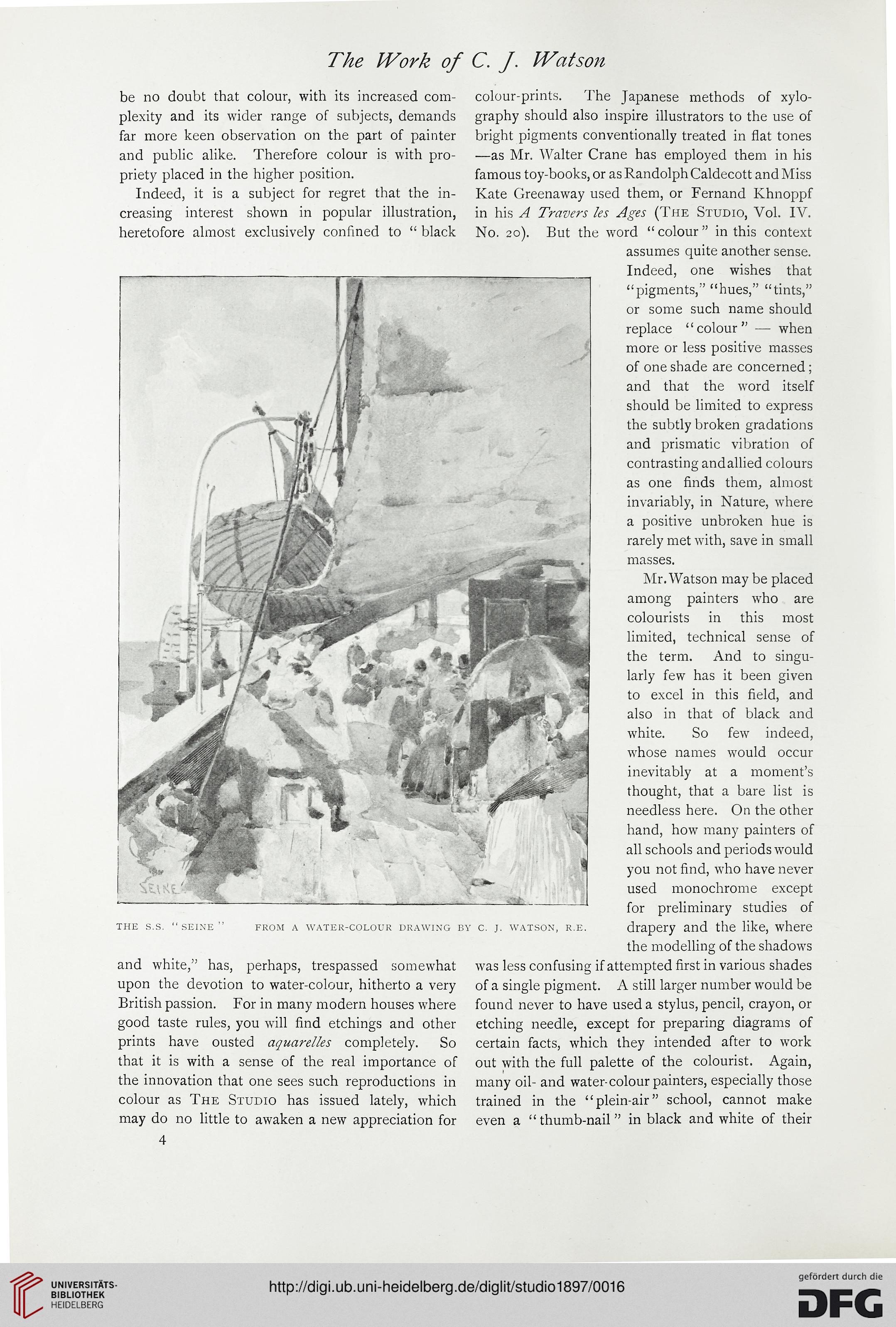The Work of C. J. Watson
be no doubt that colour, with its increased com- colour-prints. The Japanese methods of xylo-
plexity and its wider range of subjects, demands graphy should also inspire illustrators to the use of
far more keen observation on the part of painter bright pigments conventionally treated in flat tones
and public alike. Therefore colour is with pro- —as Mr. Walter Crane has employed them in his
priety placed in the higher position. famous toy-books, or as Randolph Caldecott and Miss
Indeed, it is a subject for regret that the in- Kate Greenaway used them, or Fernand Khnoppf
creasing interest shown in popular illustration, in his A Travers les Ages (The Studio, Vol. IV.
heretofore almost exclusively confined to "black No. 20). But the word "colour" in this context
assumes quite another sense.
Indeed, one wishes that
"pigments/' "hues," "tints,"
or some such name should
replace "colour" — when
more or less positive masses
of one shade are concerned;
and that the word itself
should be limited to express
the subtly broken gradations
and prismatic vibration of
contrasting andallied colours
as one finds them, almost
invariably, in Nature, where
a positive unbroken hue is
rarely met with, save in small
masses.
Mr. Watson may be placed
among painters who are
colourists in this most
limited, technical sense of
the term. And to singu-
larly few has it been given
to excel in this field, and
also in that of black and
white. So few indeed,
whose names would occur
inevitably at a moment's
thought, that a bare list is
needless here. On the other
hand, how many painters of
all schools and periods would
you not find, who have never
used monochrome except
for preliminary studies of
the s.s. "seine" from a water-colour drawing by c. j. watson, r.e. drapery and the like, where
the modelling of the shadows
and white," has, perhaps, trespassed somewhat was less confusing if attempted first in various shades
upon the devotion to water-colour, hitherto a very of a single pigment. A still larger number would be
British passion. For in many modern houses where found never to have used a stylus, pencil, crayon, or
good taste rules, you will find etchings and other etching needle, except for preparing diagrams of
prints have ousted aquarelles completely. So certain facts, which they intended after to work
that it is with a sense of the real importance of out with the full palette of the colourist. Again,
the innovation that one sees such reproductions in many oil- and water-colour painters, especially those
colour as The Studio has issued lately, which trained in the "plein-air" school, cannot make
may do no little to awaken a new appreciation for even a " thumb-nail" in black and white of their
4
be no doubt that colour, with its increased com- colour-prints. The Japanese methods of xylo-
plexity and its wider range of subjects, demands graphy should also inspire illustrators to the use of
far more keen observation on the part of painter bright pigments conventionally treated in flat tones
and public alike. Therefore colour is with pro- —as Mr. Walter Crane has employed them in his
priety placed in the higher position. famous toy-books, or as Randolph Caldecott and Miss
Indeed, it is a subject for regret that the in- Kate Greenaway used them, or Fernand Khnoppf
creasing interest shown in popular illustration, in his A Travers les Ages (The Studio, Vol. IV.
heretofore almost exclusively confined to "black No. 20). But the word "colour" in this context
assumes quite another sense.
Indeed, one wishes that
"pigments/' "hues," "tints,"
or some such name should
replace "colour" — when
more or less positive masses
of one shade are concerned;
and that the word itself
should be limited to express
the subtly broken gradations
and prismatic vibration of
contrasting andallied colours
as one finds them, almost
invariably, in Nature, where
a positive unbroken hue is
rarely met with, save in small
masses.
Mr. Watson may be placed
among painters who are
colourists in this most
limited, technical sense of
the term. And to singu-
larly few has it been given
to excel in this field, and
also in that of black and
white. So few indeed,
whose names would occur
inevitably at a moment's
thought, that a bare list is
needless here. On the other
hand, how many painters of
all schools and periods would
you not find, who have never
used monochrome except
for preliminary studies of
the s.s. "seine" from a water-colour drawing by c. j. watson, r.e. drapery and the like, where
the modelling of the shadows
and white," has, perhaps, trespassed somewhat was less confusing if attempted first in various shades
upon the devotion to water-colour, hitherto a very of a single pigment. A still larger number would be
British passion. For in many modern houses where found never to have used a stylus, pencil, crayon, or
good taste rules, you will find etchings and other etching needle, except for preparing diagrams of
prints have ousted aquarelles completely. So certain facts, which they intended after to work
that it is with a sense of the real importance of out with the full palette of the colourist. Again,
the innovation that one sees such reproductions in many oil- and water-colour painters, especially those
colour as The Studio has issued lately, which trained in the "plein-air" school, cannot make
may do no little to awaken a new appreciation for even a " thumb-nail" in black and white of their
4




